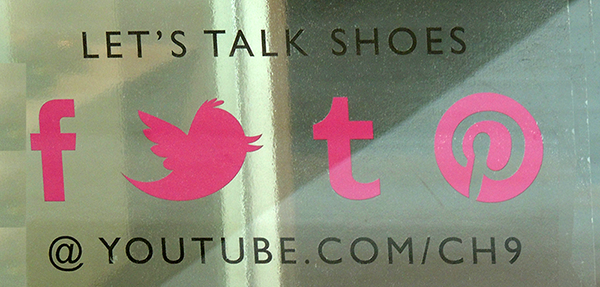
The Fashion Mall at Keystone at the Crossing is Indianapolis’ swanky mall. It’s the kind of place where I look at prices and burst out laughing, where designer labels are of the utmost importance and everything smells vaguely of freesia. Recently, Lorraine and I explored the mall as part of research for a client, looking for great social media examples. In this wealthy playground, I expected to find social media calls to action plastered everywhere. After all, more than half of all Americans own smartphones, and that number skyrockets when you’re dealing with the high-income set.
But we were wrong. Oh, sure, we saw the usual Facebook logos and web URLs, usually placed discreetly on windows or on little silver signs by the cash register, but even those were absent in some big-name, high-priced stores. Think Crate & Barrel, Pottery Barn, Banana Republic, Godiva and on and on. All without even a single URL on their printed material or a classy little Twitter bird. It’s not as if these companies aren’t using social media–most of them have more than a million fans on Facebook, active Twitter accounts and big Pinterest accounts. Their absence was conspicuous.
Where we saw these social media symbols and calls to action were in the more middle-of-the-road brands: Nine West, Urban Outfitters, Pinkberry, the Clinique counter at Nordstrom and more. Still tastefully, these brands incorporated mobile apps, social icons and iPad displays into their storerooms and marketing materials. Why there and not in the very tip-top brands? I’ve got a few theories.
- They feel they’ve got enough social media fans already. Possible, but unlikely. As long as you’re paying someone to manage your social media accounts, wouldn’t you constantly want to grow that community and keep people coming back to your store again and again?
- They don’t feel store-to-online marketing is effective. Maybe they’ve tried in the past and haven’t seen a payoff from people converting via mobile apps or they think people simply ignore the calls to action.
- It seems tacky or crass. Again, possible, but all of these stores had posters, flyers, wall hangings and other materials touting sales, return policies, corporate creedos–why not their website?
- They don’t see a value in driving people who are already in their store to an online portal. If so, this is short-sighted thinking at its worst. You’ve got them in once, but how do you keep the relationship going?
Those all have varying degrees of potential. But my theory? In an age where we can learn anything we want with the touch of a button, there’s a certain cache in talking to a real-live person. While these stores embrace social media, they’re traditionalists when it comes to the in-store experience and want to talk to people and steer them toward high-value items rather than having them scouring their phones for deals.
There’s a happy medium to be struck here. Retail locations should give customers real reasons to visit their websites and social media properties…after they leave the store. Ask for their email address on checkout and send them a coupon for 10% off their next visit. Have those great store associates tell them that they can find great recipes they can use with that beautiful Le Creuset stockpot on their Pinterest board–oh, and here’s a card with the information. Use your staff to educate and inform in-store and your social media to keep the love going at home.
Have you noticed this divide?
